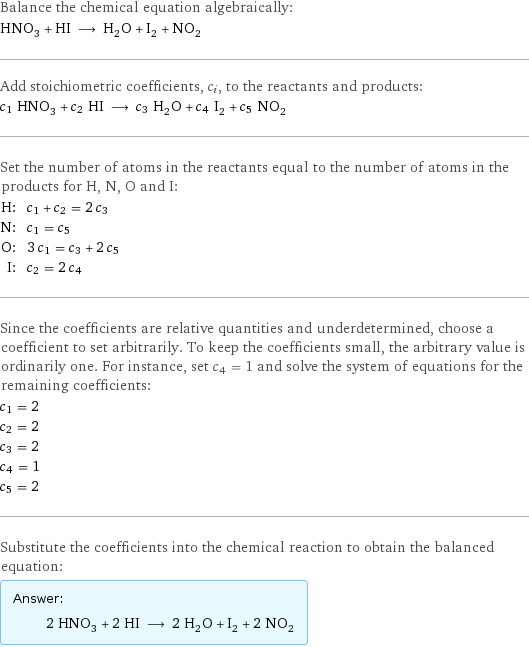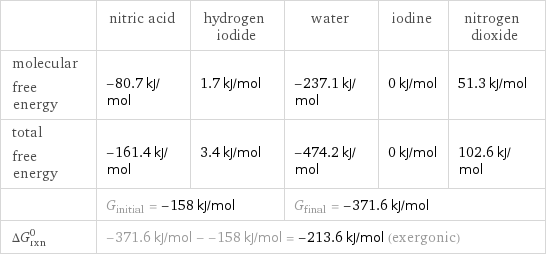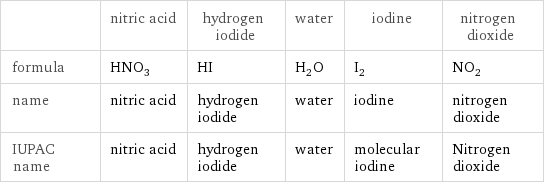Input interpretation

HNO_3 nitric acid + HI hydrogen iodide ⟶ H_2O water + I_2 iodine + NO_2 nitrogen dioxide
Balanced equation

Balance the chemical equation algebraically: HNO_3 + HI ⟶ H_2O + I_2 + NO_2 Add stoichiometric coefficients, c_i, to the reactants and products: c_1 HNO_3 + c_2 HI ⟶ c_3 H_2O + c_4 I_2 + c_5 NO_2 Set the number of atoms in the reactants equal to the number of atoms in the products for H, N, O and I: H: | c_1 + c_2 = 2 c_3 N: | c_1 = c_5 O: | 3 c_1 = c_3 + 2 c_5 I: | c_2 = 2 c_4 Since the coefficients are relative quantities and underdetermined, choose a coefficient to set arbitrarily. To keep the coefficients small, the arbitrary value is ordinarily one. For instance, set c_4 = 1 and solve the system of equations for the remaining coefficients: c_1 = 2 c_2 = 2 c_3 = 2 c_4 = 1 c_5 = 2 Substitute the coefficients into the chemical reaction to obtain the balanced equation: Answer: | | 2 HNO_3 + 2 HI ⟶ 2 H_2O + I_2 + 2 NO_2
Structures

+ ⟶ + +
Names

nitric acid + hydrogen iodide ⟶ water + iodine + nitrogen dioxide
Reaction thermodynamics
Gibbs free energy

| nitric acid | hydrogen iodide | water | iodine | nitrogen dioxide molecular free energy | -80.7 kJ/mol | 1.7 kJ/mol | -237.1 kJ/mol | 0 kJ/mol | 51.3 kJ/mol total free energy | -161.4 kJ/mol | 3.4 kJ/mol | -474.2 kJ/mol | 0 kJ/mol | 102.6 kJ/mol | G_initial = -158 kJ/mol | | G_final = -371.6 kJ/mol | | ΔG_rxn^0 | -371.6 kJ/mol - -158 kJ/mol = -213.6 kJ/mol (exergonic) | | | |
Equilibrium constant
![Construct the equilibrium constant, K, expression for: HNO_3 + HI ⟶ H_2O + I_2 + NO_2 Plan: • Balance the chemical equation. • Determine the stoichiometric numbers. • Assemble the activity expression for each chemical species. • Use the activity expressions to build the equilibrium constant expression. Write the balanced chemical equation: 2 HNO_3 + 2 HI ⟶ 2 H_2O + I_2 + 2 NO_2 Assign stoichiometric numbers, ν_i, using the stoichiometric coefficients, c_i, from the balanced chemical equation in the following manner: ν_i = -c_i for reactants and ν_i = c_i for products: chemical species | c_i | ν_i HNO_3 | 2 | -2 HI | 2 | -2 H_2O | 2 | 2 I_2 | 1 | 1 NO_2 | 2 | 2 Assemble the activity expressions accounting for the state of matter and ν_i: chemical species | c_i | ν_i | activity expression HNO_3 | 2 | -2 | ([HNO3])^(-2) HI | 2 | -2 | ([HI])^(-2) H_2O | 2 | 2 | ([H2O])^2 I_2 | 1 | 1 | [I2] NO_2 | 2 | 2 | ([NO2])^2 The equilibrium constant symbol in the concentration basis is: K_c Mulitply the activity expressions to arrive at the K_c expression: Answer: | | K_c = ([HNO3])^(-2) ([HI])^(-2) ([H2O])^2 [I2] ([NO2])^2 = (([H2O])^2 [I2] ([NO2])^2)/(([HNO3])^2 ([HI])^2)](../image_source/6a0038f04e26cd063a3693f9a246edc8.png)
Construct the equilibrium constant, K, expression for: HNO_3 + HI ⟶ H_2O + I_2 + NO_2 Plan: • Balance the chemical equation. • Determine the stoichiometric numbers. • Assemble the activity expression for each chemical species. • Use the activity expressions to build the equilibrium constant expression. Write the balanced chemical equation: 2 HNO_3 + 2 HI ⟶ 2 H_2O + I_2 + 2 NO_2 Assign stoichiometric numbers, ν_i, using the stoichiometric coefficients, c_i, from the balanced chemical equation in the following manner: ν_i = -c_i for reactants and ν_i = c_i for products: chemical species | c_i | ν_i HNO_3 | 2 | -2 HI | 2 | -2 H_2O | 2 | 2 I_2 | 1 | 1 NO_2 | 2 | 2 Assemble the activity expressions accounting for the state of matter and ν_i: chemical species | c_i | ν_i | activity expression HNO_3 | 2 | -2 | ([HNO3])^(-2) HI | 2 | -2 | ([HI])^(-2) H_2O | 2 | 2 | ([H2O])^2 I_2 | 1 | 1 | [I2] NO_2 | 2 | 2 | ([NO2])^2 The equilibrium constant symbol in the concentration basis is: K_c Mulitply the activity expressions to arrive at the K_c expression: Answer: | | K_c = ([HNO3])^(-2) ([HI])^(-2) ([H2O])^2 [I2] ([NO2])^2 = (([H2O])^2 [I2] ([NO2])^2)/(([HNO3])^2 ([HI])^2)
Rate of reaction
![Construct the rate of reaction expression for: HNO_3 + HI ⟶ H_2O + I_2 + NO_2 Plan: • Balance the chemical equation. • Determine the stoichiometric numbers. • Assemble the rate term for each chemical species. • Write the rate of reaction expression. Write the balanced chemical equation: 2 HNO_3 + 2 HI ⟶ 2 H_2O + I_2 + 2 NO_2 Assign stoichiometric numbers, ν_i, using the stoichiometric coefficients, c_i, from the balanced chemical equation in the following manner: ν_i = -c_i for reactants and ν_i = c_i for products: chemical species | c_i | ν_i HNO_3 | 2 | -2 HI | 2 | -2 H_2O | 2 | 2 I_2 | 1 | 1 NO_2 | 2 | 2 The rate term for each chemical species, B_i, is 1/ν_i(Δ[B_i])/(Δt) where [B_i] is the amount concentration and t is time: chemical species | c_i | ν_i | rate term HNO_3 | 2 | -2 | -1/2 (Δ[HNO3])/(Δt) HI | 2 | -2 | -1/2 (Δ[HI])/(Δt) H_2O | 2 | 2 | 1/2 (Δ[H2O])/(Δt) I_2 | 1 | 1 | (Δ[I2])/(Δt) NO_2 | 2 | 2 | 1/2 (Δ[NO2])/(Δt) (for infinitesimal rate of change, replace Δ with d) Set the rate terms equal to each other to arrive at the rate expression: Answer: | | rate = -1/2 (Δ[HNO3])/(Δt) = -1/2 (Δ[HI])/(Δt) = 1/2 (Δ[H2O])/(Δt) = (Δ[I2])/(Δt) = 1/2 (Δ[NO2])/(Δt) (assuming constant volume and no accumulation of intermediates or side products)](../image_source/730a9f0b152dec29a144d312a73bf194.png)
Construct the rate of reaction expression for: HNO_3 + HI ⟶ H_2O + I_2 + NO_2 Plan: • Balance the chemical equation. • Determine the stoichiometric numbers. • Assemble the rate term for each chemical species. • Write the rate of reaction expression. Write the balanced chemical equation: 2 HNO_3 + 2 HI ⟶ 2 H_2O + I_2 + 2 NO_2 Assign stoichiometric numbers, ν_i, using the stoichiometric coefficients, c_i, from the balanced chemical equation in the following manner: ν_i = -c_i for reactants and ν_i = c_i for products: chemical species | c_i | ν_i HNO_3 | 2 | -2 HI | 2 | -2 H_2O | 2 | 2 I_2 | 1 | 1 NO_2 | 2 | 2 The rate term for each chemical species, B_i, is 1/ν_i(Δ[B_i])/(Δt) where [B_i] is the amount concentration and t is time: chemical species | c_i | ν_i | rate term HNO_3 | 2 | -2 | -1/2 (Δ[HNO3])/(Δt) HI | 2 | -2 | -1/2 (Δ[HI])/(Δt) H_2O | 2 | 2 | 1/2 (Δ[H2O])/(Δt) I_2 | 1 | 1 | (Δ[I2])/(Δt) NO_2 | 2 | 2 | 1/2 (Δ[NO2])/(Δt) (for infinitesimal rate of change, replace Δ with d) Set the rate terms equal to each other to arrive at the rate expression: Answer: | | rate = -1/2 (Δ[HNO3])/(Δt) = -1/2 (Δ[HI])/(Δt) = 1/2 (Δ[H2O])/(Δt) = (Δ[I2])/(Δt) = 1/2 (Δ[NO2])/(Δt) (assuming constant volume and no accumulation of intermediates or side products)
Chemical names and formulas

| nitric acid | hydrogen iodide | water | iodine | nitrogen dioxide formula | HNO_3 | HI | H_2O | I_2 | NO_2 name | nitric acid | hydrogen iodide | water | iodine | nitrogen dioxide IUPAC name | nitric acid | hydrogen iodide | water | molecular iodine | Nitrogen dioxide
Substance properties

| nitric acid | hydrogen iodide | water | iodine | nitrogen dioxide molar mass | 63.012 g/mol | 127.912 g/mol | 18.015 g/mol | 253.80894 g/mol | 46.005 g/mol phase | liquid (at STP) | gas (at STP) | liquid (at STP) | solid (at STP) | gas (at STP) melting point | -41.6 °C | -50.76 °C | 0 °C | 113 °C | -11 °C boiling point | 83 °C | -35.55 °C | 99.9839 °C | 184 °C | 21 °C density | 1.5129 g/cm^3 | 0.005228 g/cm^3 (at 25 °C) | 1 g/cm^3 | 4.94 g/cm^3 | 0.00188 g/cm^3 (at 25 °C) solubility in water | miscible | very soluble | | | reacts surface tension | | | 0.0728 N/m | | dynamic viscosity | 7.6×10^-4 Pa s (at 25 °C) | 0.001321 Pa s (at -39 °C) | 8.9×10^-4 Pa s (at 25 °C) | 0.00227 Pa s (at 116 °C) | 4.02×10^-4 Pa s (at 25 °C) odor | | | odorless | |
Units
